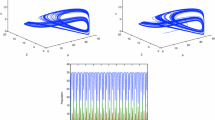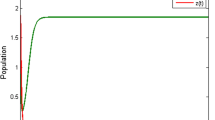Abstract
In the present work, we have developed a plankton-fish model consisting time delay using functional response Holling type-II and linear harvesting. Two different additional foods are supplied to both the species zooplankton and fish and study which one additional food more influences positively to the system than other. We derive some stipulations for existence of equilibria and its stability. Stipulations for local and global stability, positivity and boundedness of the system are investigated. Stability and instability analysis have been performed through the time series, phase space and bifurcation diagrams with respect to various ecological factors. In both cases, presence of delay and absence of delay, the main observation of the study indicates that the low additional food supply to zooplankton has an extinction risk for both the species fish and themselves, although the certain additional food is provided to the fish. It is beneficial not only for the zooplankton but also for the fish in both cases. It is also observed that enhancing the additional food supply of the zooplankton in presence of delay is more advantageable than in absence of delay, because of, delay enhances that quantity of additional food supply to a certain level without changing the stable nature of the system for which the system exhibits a stable dynamic in absence of delay. The complex behaviour (chaos) which is appeared due to conversion rate and small harvesting of zooplankton that can be completely controlled by the delay. Double Hopf bifurcation behaviour has been inspected due to delay. A small gestation delay has destabilizing effect, whereas a relatively large gestation delay has stabilizing effect.













Similar content being viewed by others
Data availability
No data set is generated to this article.
References
Raw, S.N., Tiwari, B., Mishra, P.: Analysis of plankton fish model with external toxicity and non linear harvesting. Ricerche. Mat. 69, 653–681 (2020)
Saha, T., Bandyopadhyay, M.: Dynamical analysis of toxin producing Phytoplankton-Zooplankton interactions. Nonlinear Anal. Real World Appl. 10(1), 314–332 (2009)
Anderson, D.: Turning back the harmful red tide. Nature 388, 513–514 (1997)
Du, Y., Hsu, S.: On a nonlocal reaction-diffusion problem arising from the modeling of phytoplankton growth. SIAM J. Math. Anal. 42(3), 1305–1333 (2010)
Du, Y., Mei, L.: On a nonlocal reaction-diffusion-advection equation modelling phytoplankton dynamics. Nonlinearity 24, 319–349 (2011)
Hsu, S., Lou, Y.: Single phytoplankton species growth with light and advection in a water column. SIAM J. Appl. Math. 70(8), 2942–2974 (2010)
Rani, R., Gakkhar, S.: The impact of provision of additional food to predator in predator-prey model with combined harvesting in the presence of toxicity. J. Appl. Math. Comput. 60, 673–701 (2019)
Pal, R., Basu, D., Banerjee, M.: Modelling of phytoplankton allelopathy with Monod-Haldane-type functional response—a mathematical study. Biosystem 95(3), 243–253 (2009)
Hutchinson, G.E.: Circular causal systems in ecology. Ann. N. Y. Acad. Sci. 50(4), 221–246 (1948)
Cushing, J.M.: Integro-Differential Equations and Delay Model in Population Dynamics. Springer, Heidelberg (1977)
Kuang, Y.: Delay Differential Equations with Applications in Population Dynamics. Academic Press, New York (1993)
Gopalsamy, K.: Stability and Oscillations in Delay Differential Equations of Population Dynamics. Kluwer Academic, Dordrecht (1992)
MacDonald, N.: Time Lags in Biological Models. Springer, Heidelberg (1978)
Hastings, A.: Delays in recruitment at different trophic levels: effects on stability. J. Math. Biol. 21, 35–44 (1984)
Gopalsamy, K.: Harmless delay in model systems. Bull. Math. Biol. 45, 295–309 (1983)
May, R.M.: Time delay versus stability in population models with two and three trophic levels. Ecology 54(2), 315–325 (1973)
Ruan, S.: Absolute stability, conditional stability and bifurcation in Kolmogorov-type predator-prey systems with discrete delays. Quart. Appl. Math. 59(1), 159–173 (2001)
Freedman, H.I., Wolkowicz, G.S.K.: Predator-prey systems with group defense: the paradox of enrichment revisited. Bull. Math. Biol. 48(5–6), 493–508 (1986)
Erbe, L.H., Freedman, H.I., Rao, S.H.R.: Three-species food-chain models with mutual interference and time delays. Math. Biosci. 80(1), 57–80 (1986)
Freedman, H.I., Rao, S.H.R.: The trade-off between mutual interference and time lags in predator-prey systems. Bull. Math. Biol. 45(6), 991–1004 (1983)
Hassell, M.P.: Mutual interference between searching insect parasites. J. Animat. Ecol. 40, 473–486 (1971)
Rogers, D.J., Hassell, M.P.: General models for insect parasite and predator searching behavior: interference. J. Animat. Ecol. 43, 239–253 (1974)
Rao, F., Chavez, C.C., Kang, Y.: Dynamics of a diffusion reaction prey-predator model with delay in prey: effects of delay and spatial components. J. Math. Anal. Appl. 461, 1177–1214 (2018)
Scheffer, M.: Fish and nutrients interplay determines algal biomass: a minimal model. Oikos 62, 271–282 (1991)
Freedman, H.I., Ruan, S.: Hopf bifurcation in three-species food chain models with group defense. Math. Biosci. 111(1), 73–87 (1992)
Das, K., Ray, S.: Effect of delay on nutrient cycling in phytoplankton-zooplankton interactions in estuarine system. Ecol. Model. 215(1–3), 69–76 (2008)
Ojha, A., Thakur, N.K.: Exploring the complexity and chaotic behavior in plankton-fish system with mutual interference and time delay. Biosystem 198, 104283 (2020)
Srinivasu, P.D.N., Prasad, B.S.R.V., Venkatesulu, M.: Biological control through provision of additional food to predators: a theoretical study. Theor. Popul. Biol. 72(1), 111–120 (2001)
van Baalen, M., Krivan, V., van Rijn, P.C., Sabelis, M.W.: Alternative food, switching predators, and the persistence of predator-prey systems. Am. Nat. 157(5), 512–24 (2001)
Murdoch, W.W.: Switching in general predators: experiments on predator specificity and stability of prey populations. Ecol. Mono. 39(4), 335–354 (1969)
Holt, R.D.: Predation, apparent competition, and the structure of prey communities. Theor. Popul. Biol. 12(2), 197–229 (1977)
Mondal, S., Maiti, A., Samanta, G.P.: Effects of fear and additional food in a delayed predator-prey model. Biophys. Rev. Lett. 13(4), 157–177 (2018)
Srinivasu, P.D.N., Prasad, B.S.R.V.: Role of quantity of additional food to predators as a control in predator-prey systems with relevance to pest management and biological conservation. Bull. Math. Biol. 73, 2249–2276 (2011)
Maiti, A., Pal, A.K., Samanta, G.P.: Effect of time-delay on a food chain model. Appl. Math. Comput. 200(1), 189–203 (2008)
Sharma, A., Sharma, A.K., Agnihotri, K.: Complex dynamic of plankton-fish interaction with quadratic harvesting and time delay. Model. Earth. Syst. Environ. 2, 1–17 (2016)
Sahoo, B., Poria, S.: Disease control in a food chain model supplying alternative food. Appl. Math. Model. 37(8), 5653–5663 (2013)
Haque, M., Greenhalgh, D.: When a predator avoids infected prey: a model-based theoretical study. Math. Med. Biol. 27(1), 75–94 (2010)
Hethcote, H.W., Wang, W., Han, L., Ma, Z.: A predator-prey model with infected prey. Theor. Popul. Biol. 66, 259–268 (2004)
Pal, S., Chatterjee, A.: Dynamics of the interaction of plankton and planktivorous fish with delay. Cogent Math. 2(1), 1074337 (2015)
Panja, P., Mondal, S.K., Jana, D.K.: Effects of toxicants on Phytoplankton-Zooplankton-Fish dynamics and harvesting. Chaos Solitons Fractals 104, 389–399 (2017)
Jana, D., Agrawal, R., Upadhyay, R.K.: Top-predator interference and gestation delay as determinants of the dynamics of a realistic model food chain. Chaos Solitons Fractals 69, 50–63 (2014)
Mondal, S., Samanta, G.P.: Dynamics of an additional food provided predator-prey system with prey refuge dependent on both species and constant harvest in predator. Phys. A 534, 122301 (2019)
Clark, C.W.: Mathematical Bioeconomics: The Optimal Management of Renewable Resources. Wiley, New York (1976)
Clark, C.W.: Bioeconomic Modeling and Fisheries Management. Wiley, New York (1985)
Martin, A., Ruan, S.: Predator-prey models with delay and prey harvesting. J. Math. Biol. 43, 247–267 (2001)
Beddington, J.R., May, R.M.: Maximum sustainable yields in systems subject to harvesting at more than one trophic level. Math. Biosci. 51(3–4), 261–281 (1980)
Adak, D., Bairagi, N., Hakl, R.: Chaos in delay-induced Leslie-Gower prey-predator-parasite model and its control through prey harvesting. Nonlinear Anal. Real World Appl. 51, 102998 (2020)
Yang, R., Zhang, C.: Dynamics in a diffusive modified Leslie-Gower predator-prey model with time delay and prey harvesting. Nonlinear Dyn. 87, 863–878 (2017)
Wang, Y., Jiang, W., Wang, H.: Stability and global Hopf bifurcation in toxic phytoplankton-zooplankton model with delay and selective harvesting. Nonlinear Dyn. 73, 881–896 (2013)
Wang, B., Wang, A.L., Liu, Y.J., Liu, Z.H.: Analysis of a spatial predator-prey model with delay. Nonlinear Dyn. 62, 601–608 (2010)
Gupta, R.P., Chandra, P.: Bifurcation analysis of modified Leslie-Gower predator-prey model with Michaelis-Menten type prey harvesting. J. Math. Anal. Appl. 398, 278–295 (2013)
Zhang, Z., Yang, H., Fu, M.: Hopf bifurcation in a predator-prey system with Holling type III functional response and time delays. J. Appl. Math. Comput. 44, 337–356 (2014)
Song, Y., **ao, W., Qi, X.: Stability and Hopf bifurcation of a predator-prey model with stage structure and time delay for the prey. Nonlinear Dyn. 83, 1409–1418 (2016)
Sharma, A., Sharma, A.K., Agnihotri, K.: Analysis of a toxin producing phytoplankton-zooplankton interaction with Holling IV type scheme and time delay. Nonlinear Dyn. 81, 13–25 (2015)
Thakur, N.K., Ojha, A., Jana, D., Upadhyay, R.K.: Modeling the plankton-fish dynamics with top predator interference and multiple gestation delays. Nonlinear Dyn. 100, 4003–4029 (2020)
Ruan, S.: Persistence and coexistence in zooplankton-phytoplankton-nutrient models with instantaneous nutrient recycling. J. Math. Biol. 31, 633–654 (1993)
Fan, A., Han, P., Wang, K.: Global dynamics of a nutrientplankton system in the water ecosystem. Appl. Math. Comput. 219(15), 8269–8276 (2013)
Zhao, J., Wei, J.: Stability and bifurcation in a two harmful phytoplankton-zooplankton system. Chaos Solitons Fractals 39(3), 1395–1409 (2009)
Edwards, A.M., Brindley, J.: Zooplankton mortality and the dynamical behaviour of plankton population models. Bull. Math. Biol. 61(2), 303–339 (1999)
Gakkhar, S., Singh, A.: Complex dynamics in a prey predator system with multiple delays. Commun. Nonlinear Sci. Numer. Simulat. 17(2), 914–929 (2012)
Hassard, B.D., Kazarinoff, N.D., Wan, W.H.: Theory and Applications of Hopf Bifurcation. Cambridge University Press, Cambridge (1981)
Yang, X., Chen, L., Chen, J.: Permanence and positive periodic solution for the single species nonautonomus delay diffusive model. Comput. Math. Appl. 32, 109–116 (1996)
Acknowledgements
The work is supported by MATRICS project (File No.: MTR/2021/000472) SERB-DST New Delhi, India to the corresponding author S. N. Raw and is also supported by UGC New Delhi, India to the co-author S. R. Sahu under Junior Research Fellowship (JRF) Award. The authors are thankful to Dr. Pau Martin, Associate Editor and the reviewers for their valuable suggestions and remarks in sha** the manuscript into its current form.
Author information
Authors and Affiliations
Corresponding author
Ethics declarations
Conflict of interest
No conflict of interest.
Additional information
Publisher's Note
Springer Nature remains neutral with regard to jurisdictional claims in published maps and institutional affiliations.
Rights and permissions
Springer Nature or its licensor (e.g. a society or other partner) holds exclusive rights to this article under a publishing agreement with the author(s) or other rightsholder(s); author self-archiving of the accepted manuscript version of this article is solely governed by the terms of such publishing agreement and applicable law.
About this article
Cite this article
Raw, S.N., Sahu, S.R. Dynamical complexities with effect of additional food and harvesting in the time delay plankton-fish model. SeMA (2023). https://doi.org/10.1007/s40324-023-00339-z
Received:
Accepted:
Published:
DOI: https://doi.org/10.1007/s40324-023-00339-z




